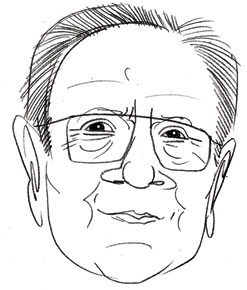
Disparate images blur and merge. A boy in Midnapore in West Bengal wakes up at the crack of dawn and walks to school four miles away, barefoot. After school, he first grazes cattle and then returns to home and hearth where he solves maths problems by a fickle wick lamp.
A billionaire scientist wakes up in a marble mansion in California overlooking the Pacific Ocean. He hops into his Rolls Royce and heads for the University of California, Los Angeles (UCLA). He will be establishing a research centre there. His $11 million donation is supposed help top physicists address unanswered questions of nature through intricate mathematical models.
Born in a "blackhole of poverty", a "primitive society submersed in famine, pestilence and blind faith", Mani Lal Bhaumik, laser physicist, entrepreneur and philanthropist, has come a long way.
It was his love for Mathematics and Physics that changed the course of Bhaumik's life. First came the scholarship from Kola Union High School, Kolaghat. It helped him take that "quantum leap" from Midnapore to Calcutta, where he eventually found a mentor in physicist Satyendra Nath Bose; he was then studying MSc in Physics at Cal-cutta University.
"This was the early 1950s. I happened to attend a lecture on quantum field theory by Nobel-prize-winning physicist Paul Dirac. Though much of what he said went over my head, I was as enchanted as a young sailor experiencing the allure of hearing his first siren song," wrote Bhaumik in his autobiography Code Name God: The Spiritual Odyssey of a Man of Science, published 12 years ago.
He wanted to "follow the song" but couldn't pursue a career in Theoretical Physics because his schoolteacher father wanted him to follow in his footsteps. Bhaumik even did so for a while before he joined the Indian Institute of Technology, Kharagpur, to pursue a PhD in Physics. Later, based on a recommendation from S.N. Bose, he got a post-doctoral fellowship at UCLA.
But there, his American professor veered him away from pure Physics. "I plunged into the field of Laser Physics which was just exploding," Bhaumik tells The Telegraph, on the sidelines of the 15th anniversary celebrations of his educational foundation, at a five-star hotel in Calcutta.
His pioneering research in high-energy laser found applications in laser printers, the vision-correcting excimer laser and even DVD players. "Nowadays our patented argon-fluoride laser technology is finding use in photolithography, carving out a niche in the $400-billion market in microcomputers such as smartphones," he adds.
Despite the billions he made, Bhaumik continued to nurture his love for Mathematics and Theoretical Physics. To fulfill his unrealised dream he donated millions to UCLA. Nobel laureate and physi-cist Prof. David Gross helped him found the research centre. "It's very difficult to raise funds for this subject because people don't understand what theoretical physicists do," says Bhaumik.
It is not just UCLA; Bhaumik has donated Rs 400 crores to his alma mater, IIT Kharagpur, to create the Bhaumik International Centre for Advanced Research (Bicar) in Calcutta for postgraduate studies and research. Unfortunately, red tape has come in the way. "The institute in UCLA was complete in just six months, but I haven't been able to get ahead with my Calcutta institute for the last six years. But I am an optimistic person. I am sure I'll make my dream institute a reality."
He has also donated a substantial amount to the National Institute of Advanced Studies (NIAS) at the Indian Institute of Science in Bangalore. The interdisciplinary research programme at NIAS is a confluence of philosophy, cognitive sciences, animal studies, psychology, creativity studies, physics and the neurosciences.
Bhaumik turns 86 in March. The urge to give back is getting stronger as age catches up with him. He has also been leaning towards a kind of asceticism and spirituality. But 30 years ago he was a completely different man. His 12 patents for co-inventing high-energy laser techniques at two US companies - Xerox and Northrop - fetched him ample stock options, which appreciated by 50 times. "I had a whole lot of money at hand. This gave me a springboard for investments - stocks, bonds, properties, buildings and homes."
His gamble paid off handsomely as there was a real estate boom in California in the late 1970s. Within just a few years, Bhaumik owned six hilltop houses with million-dollar postcard views. He writes, "At the age of 55 I took an early retirement from Northrop and set my sights on satisfying every desire that had ever seemed beyond my grasp."
His life turned into a series of parties and he flew where his fancy took him along with girlfriends from America and Sweden and Russia. The bachelor physicist went on to date some of the most beautiful women of Hollywood - Eva Gabor, Roberta Collins and Catherine Oxenberg. His lavish parties featured the who's who of Hollywood and even former US presidents - Ronald Reagan and Bill Clinton.
One day, after one such gala dinner beside his Olympic-sized pool, he had an epiphany. Bhaumik says he realised he was an intensely unhappy man. It seemed to him that the Mahatma - whom he had met fleetingly as a boy at a camp near his village - was whispering in his ears, "Happiness is an inside job, Mani."
Soon after, Bhaumik embarked on his "spiritual odyssey". On the one hand, he studied the latest developments of Theoretical Physics. On the other, he started a new chapter in philanthropy. In 1999, he founded the Dr Mani Bhaumik Educational Foundation to help the deprived through education. But Bhaumik mentions that he keeps away from the selection of scholars and the scholars themselves; he doesn't want to pose as their benefactor.
To get children interested in Quantum Physics and Cosmology, he has created a cartoon series called Cosmic Quantum Ray.
His own books, Code Name God and The Cosmic Detective, meant to popularise science, have been on bestseller lists. But they have also elicited scathing criticism. Some have called them attempts to oversimplify science. Scientist Partha Ghose wrote a scathing review of Code Name God in the magazine Desh, where he said it was replete with scientific mistakes and a mere effort to gain popularity.
Bhaumik simply says, "I wrote Code Name God to share my life story. Also, I wish to tell common people the latest developments of Physics in a simple language."
He is now ready to pen his next book and open ever newer chapters of Physics.










